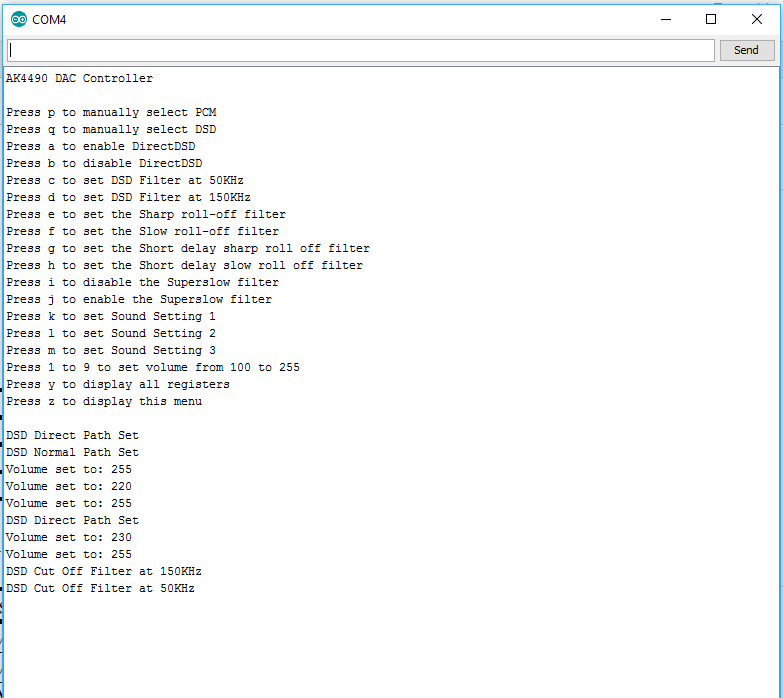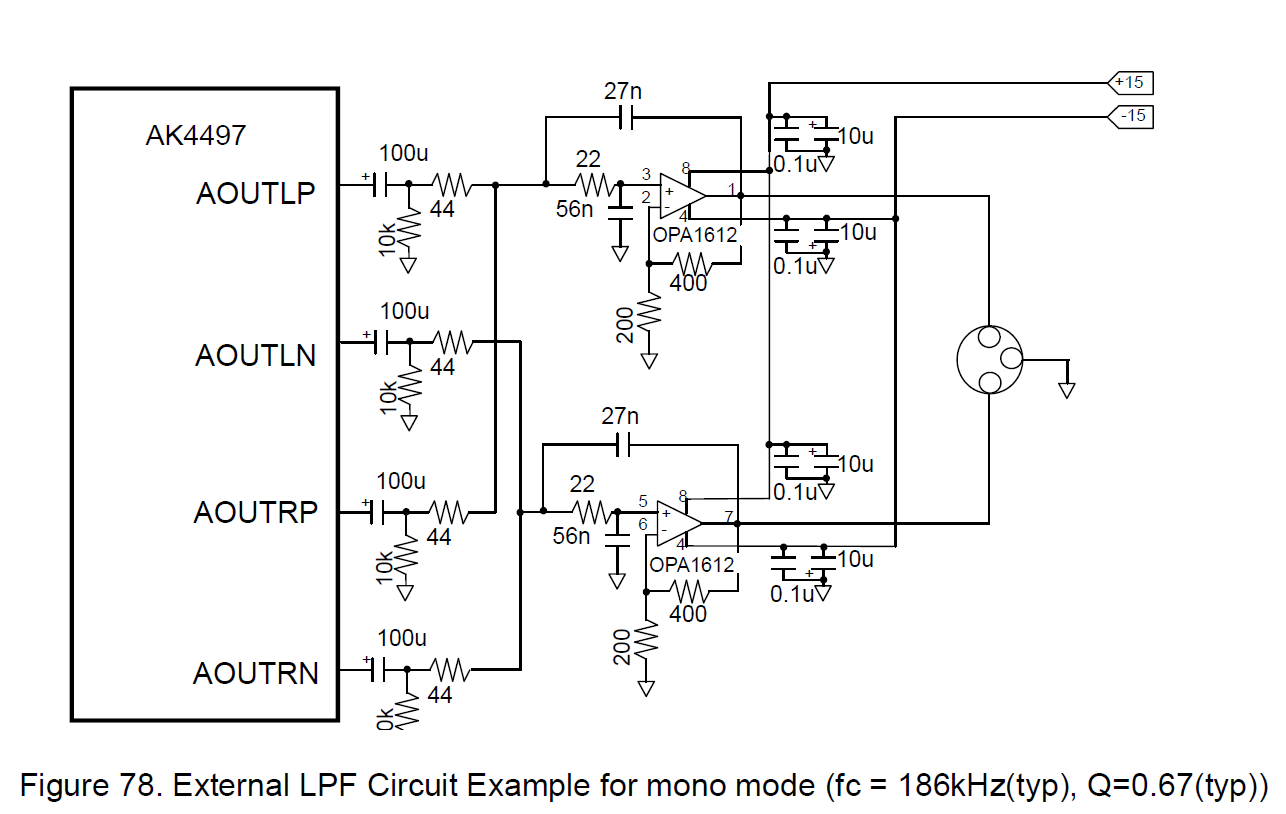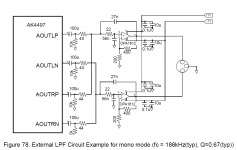DAC works on single supply voltage. The current sources within the DAC sit at half the supply voltage, which is represented at the outputs. In case of current output DACs the Iout should ideally sit at 0v (virtual ground). In case of Vout DACs the +inputs of the internal opamp are connected to the reference voltage and thus the output is at Vcc/2.
This is the same for both phases of each output and thus there is no relative offset between the two phases.
Thanks... I assumed it would be the same as 4396 where V outs are centered around VCOM but looking at the datasheet for the 4490 it is not.
However, the 4497 datasheet states that the outputs are centered around VCML and VCMR!
The last postal service of 2016 saw the delivery of my Yanasoft dual-mono AK4497 kit.
AK4497DM DAC??
I've now had time to study the board and the output is not the same as the schematic in the AK4497 datasheet. There are no caps at the outputs and the AOUTRP/AOUTLP and AOUTRN/AOUTLN pairs are simply routed, via resistor pads, to be summed at the differential output +/- pins. For voltage out the resistors are 0R links but the documentation specifies 2K0 to trade off some voltage for current.
I will try to work through Yana San's blog entries to see if there is more information.
Anyway, it's a nice quality PCB. I now have to set about assembly/configuration of the board.
AK4497DM DAC??
I've now had time to study the board and the output is not the same as the schematic in the AK4497 datasheet. There are no caps at the outputs and the AOUTRP/AOUTLP and AOUTRN/AOUTLN pairs are simply routed, via resistor pads, to be summed at the differential output +/- pins. For voltage out the resistors are 0R links but the documentation specifies 2K0 to trade off some voltage for current.
I will try to work through Yana San's blog entries to see if there is more information.
Anyway, it's a nice quality PCB. I now have to set about assembly/configuration of the board.
P and N aren't opposite of each other? And P and N don't each average to gnd?
They are out of phase, yes, but they sit at the same DC level. This is what is important for transformers - that there is no DC difference on its inputs.
I was rather daunted by the prospect of soldering my AK4497 kit as there is a lot of scope for getting it wrong with the small ICs etc. Anyway, a friend with considerable experience of this sort of soldering, and a far better equipped workshop, has agreed to take on the tricky elements of the assembly. I've just shipped the board and parts to him so I'll now get my head around the configuration etc. More news in due course.
Those resistors and caps *are* summing the outputs. Each summed output is fed to an LPF - so yes, you can use a transformer instead of the two opamps. I would not eliminate any of those components.
I understand that the caps are doing DC blocking. Do they also play a role in the output summing?
Thinking like a total n00b, I am considering omitting the caps and applying a voltage equal to Vref/2 at the opamps' inverting inputs. Wouldn't that cancel out the DC?
Attachments
I posted this message some time ago by mistake in the wrong thread.. I'm reposting here where it is a lot more relevant:
I finally received my AK4490 test boards and built one to make sure that I had a proper handle on things. Everything seems to be working fine.
I wrote a piece of Arduino code to control pretty much every parameter of the chip that relates to sound quality for my single chip board. I've put it up on my blog.
It accepts commands through the serial port to change the various options. Here is its menu:

Next up is building a second unit so I can try dual mono operation.
What concerns me is the output stage. I've looked at the dual mono reference design for the 4497 part but I haven't gone as far as comparing the 4490's output characteristics with the 4497's so as to determine whether the 4497's reference design could be applicable to the 4490s.
I also don't like the 100uF capacitors in the signal path, before the summing of the signals. I would like to have full DC coupling if possible.
I'm a noob at analog electronics so any suggestions would be appreciated.
I'm OK with using op-amps but I would prefer something more "interesting", of the class-a discrete flavour. Balanced output would be preferable.
I finally received my AK4490 test boards and built one to make sure that I had a proper handle on things. Everything seems to be working fine.
I wrote a piece of Arduino code to control pretty much every parameter of the chip that relates to sound quality for my single chip board. I've put it up on my blog.
It accepts commands through the serial port to change the various options. Here is its menu:

Next up is building a second unit so I can try dual mono operation.
What concerns me is the output stage. I've looked at the dual mono reference design for the 4497 part but I haven't gone as far as comparing the 4490's output characteristics with the 4497's so as to determine whether the 4497's reference design could be applicable to the 4490s.
I also don't like the 100uF capacitors in the signal path, before the summing of the signals. I would like to have full DC coupling if possible.
I'm a noob at analog electronics so any suggestions would be appreciated.
I'm OK with using op-amps but I would prefer something more "interesting", of the class-a discrete flavour. Balanced output would be preferable.
Has anyone got experience with all 4490/4497EQ and 4495SEQ? It's confusing because 4490 is newer and with some better specs like double oversampling, lower thd+n, but still 4495SEQ is a more expensive chip apparently, and is unique in that it can take 7v analog supply. So specs aside does anyone know how they actually compare sound wise?

I understand that the caps are doing DC blocking. Do they also play a role in the output summing?
Thinking like a total n00b, I am considering omitting the caps and applying a voltage equal to Vref/2 at the opamps' inverting inputs. Wouldn't that cancel out the DC?
Far as I'm aware they would not be required in stereo operation at all in your scenario, but are needed here else the two outputs are connected directly to each other. Even small DC variances between the two outputs could cause one to exceed its dissipation limits (remember these are inside the chip, so they're exceedingly small).
Frankly for dual mono this is not the correct way of using a DAC chip of any sort, the normal practice is to first run each +/- set through a diffamp and then feed the resultant into another differential LPF. That would allow use of shallow slopes in each filter stage and properly cancel DC.
Hi do you think it's possible to add a reclock board at the output of a BBB such like a acko S03?
https://sites.google.com/site/ackodac/home
Sorry for the question but is the MCLK input PIN of the ak4495 or 97 depending on the oversampling frequency of the i2s signal or is it constant?
http://www.diyaudio.com/forums/atta...ro-isolator-reclocker-gb-bbb-ess-dac-sync.png
Here only 2 frequency are delivered to the DAC : 45.1584/49.152.
Am I Right?
https://sites.google.com/site/ackodac/home
Sorry for the question but is the MCLK input PIN of the ak4495 or 97 depending on the oversampling frequency of the i2s signal or is it constant?
http://www.diyaudio.com/forums/atta...ro-isolator-reclocker-gb-bbb-ess-dac-sync.png
Here only 2 frequency are delivered to the DAC : 45.1584/49.152.
Am I Right?
I understand that the caps are doing DC blocking. Do they also play a role in the output summing?
Thinking like a total n00b, I am considering omitting the caps and applying a voltage equal to Vref/2 at the opamps' inverting inputs. Wouldn't that cancel out the DC?
1) No... if I understand the question, the summing of output for L+/R+ and L-/R- is done after the CR HPF, and the 44R resistors are there to allow for small differences in voltage between channels.
2) If you are using the 4497 as in the picture you show, there should be small to minimal DC. 4490 will have Vcc/2 volts of DC. You can use no cap if you measure DC to be small enough for your taste (consider amplifier gain magnifying that DC by the gain factor) or use cap to be safe. If you try to apply some correcting voltage, I am not sure what would happen. At best you cancel some DC but probably not all, at worst you mess up the signal.
As far as the HPF values, you can mess with the values to get a lower valued (read non-electrolytic) capacitor... Input impedance of the opamp may factor here as well; hopefully someone can clarify whether differential or common mode input impedance applies here?
Last edited:
Has anyone tried using 7v analog supply to AK4497? A few people have said they that it bettered the sound of AK4490 even though it is only specified to take 5v. Only AK4495 is specified to take 7v, I don't understand why the new dacs aren't.
Has anyone tried using 7v analog supply to AK4497? A few people have said they that it bettered the sound of AK4490 even though it is only specified to take 5v. Only AK4495 is specified to take 7v, I don't understand why the new dacs aren't.
The new DAC runs at much higher current than the previous DACs, so i guess the limit is to do with dissipation.
Today I got my two ak4497 boards from diyihnk. I'm want to change the capacitors to 1500uf oscon 6,3v for VREFH/L and 560uf oscon 6,3v on all other location as i saw many pictures in web from people not using fr and only using oscon.
Any advise on that?
Also build two super v/i's - just waiting for a good solution to sum up the signal 🙂
Chris
Any advise on that?
Also build two super v/i's - just waiting for a good solution to sum up the signal 🙂
Chris
I would recommend you to use the oscon, solid type only on digital circuits, and without any bypass capacitors.
I received my Yanasoft dual mono AK4497 board back from my good friend Ales today; he's done a nice job of the smd soldering...
I have my Lundahl 1676 transformers for the output so I need to order the rest of the parts and find the time to see how it sounds.
An externally hosted image should be here but it was not working when we last tested it.
An externally hosted image should be here but it was not working when we last tested it.
I have my Lundahl 1676 transformers for the output so I need to order the rest of the parts and find the time to see how it sounds.
Looks very nice. Are you going to connect the transformers after the original summing section of pcb without any modifications?
What caps and values are you going to use? The pictures from yanasoft show oscon on all positions, even analog power and just 470uf on vrefh/l...
Chris
What caps and values are you going to use? The pictures from yanasoft show oscon on all positions, even analog power and just 470uf on vrefh/l...
Chris
I plan to use the transformers for the summing too;
http://www.diyaudio.com/forums/digi...al-mono-dac-ak4490-ak4497-18.html#post4933388
I need to sit down and finalise my BOM over the weekend.
Ray
http://www.diyaudio.com/forums/digi...al-mono-dac-ak4490-ak4497-18.html#post4933388
I need to sit down and finalise my BOM over the weekend.
Ray
- Home
- Source & Line
- Digital Line Level
- Dual Mono DAC AK4490/AK4497
